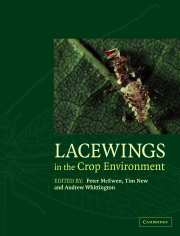Book contents
- Frontmatter
- Contents
- List of contributors
- Preface
- PART 1 Lacewing systematics and ecology
- PART 2 Lacewings in crops
- PART 3 Principles
- Introduction to Part 3
- CHAPTER 11 The use of lacewings in biological control
- CHAPTER 12 Mass-rearing, release techniques, and augmentation
- CHAPTER 13 Features of the nutrition of Chrysopidae larvae and larval artificial diets
- CHAPTER 14 Ecological studies of released lacewings in crops
- CHAPTER 15 Sampling and studying lacewings in crops
- CHAPTER 16 Interactions with plant management strategies
- CHAPTER 17 Lacewings, biological control, and conservation
- PART 4 Case studies
- PART 5 Conclusion
- Taxonomic index
- General index
CHAPTER 14 - Ecological studies of released lacewings in crops
Published online by Cambridge University Press: 04 May 2010
- Frontmatter
- Contents
- List of contributors
- Preface
- PART 1 Lacewing systematics and ecology
- PART 2 Lacewings in crops
- PART 3 Principles
- Introduction to Part 3
- CHAPTER 11 The use of lacewings in biological control
- CHAPTER 12 Mass-rearing, release techniques, and augmentation
- CHAPTER 13 Features of the nutrition of Chrysopidae larvae and larval artificial diets
- CHAPTER 14 Ecological studies of released lacewings in crops
- CHAPTER 15 Sampling and studying lacewings in crops
- CHAPTER 16 Interactions with plant management strategies
- CHAPTER 17 Lacewings, biological control, and conservation
- PART 4 Case studies
- PART 5 Conclusion
- Taxonomic index
- General index
Summary
INTRODUCTION
The effectiveness of augmentative releases of lacewings in the field has varied greatly, with experimental studies reporting from 0% to 100% pest reduction (for reviews, see Ridgway & Murphy, 1984; King et al., 1985; Daane et al., 1998). Numerous factors can influence lacewing release effectiveness, and while some can be controlled (e.g. release rate), the success or failure of many release programmes is contingent upon the ecological interactions at the release site. For this reason, to realise fully the commercial potential of lacewings, the ecological interactions among lacewings, their prey, and the release environment must be better understood. Crucial areas of ecological study discussed here include: (1) the influence of environmental or host plant conditions on lacewing performance, (2) the role of other natural enemies on released lacewing density, (3) the effect of pesticide residues in the release environment, and (4) the importance of predator-prey interactions in the field. Given the above concerns, research has recently been conducted that helps to categorise the ecological relationship of released lacewings with respect to target pest(s) and the biotic or abiotic factors in the release environment.
HABITAT INFLUENCE ON RELEASE EFFECTIVENESS
The impact of predators can vary between habitats, as described by Hodek (1993) for aphidophagous predators, and many predators may be rendered ineffective without leaving the release site. Not surprisingly, different species of lacewings appear to be associated with certain habitats, such as conifers or broad-leafed trees (New, 1975), and lacewings released into less desirable habitats may have reduced effectiveness against an otherwise acceptable prey species.
- Type
- Chapter
- Information
- Lacewings in the Crop Environment , pp. 338 - 350Publisher: Cambridge University PressPrint publication year: 2001
- 8
- Cited by



